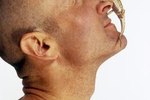
Land hermit crabs make suitable, entertaining and low-maintenance pets for a wide range of lifestyles. Their captive habitat is important to their comfortableness, happiness and, above all, their health. Their homes don't need to be fancy, and many of the items you need are inexpensive and easily found in pet-supply, hardware and big-box stores.
The Tank
A glass aquarium sold in big-box stores or pet stores is going to provide the best permanent home for your clawed friend. Be aware, though, that most of these tanks come with a mesh lid or no lid at all, and this isn't suitable for your crab. A mesh lid can be acceptable if you keep most of it covered with a damp cloth. A glass or plexi-glass cover with a few holes for air that fits over the top is going to help keep the humidity up, something your hermit crabs need to survive. The inside will need to remain warm in the mid- to high-70s or low 80s. Under-tank heaters are ideal for this, as heating rocks and other elements could burn your crab.
Substrate
Before putting anything else in your tank, your crab needs a substrate. The substrate is the material your little guy is going to run around on and play in. Hermit crabs love to build tunnels and dig around in the sand, so sand is an ideal substrate for these shelled critters. Coconut fiber and crushed coral are other suitable substrates, but they'll cost a little bit more than clean play sand.
Keeping It Moist
Land hermit crabs don't breathe under water, nor do they have lungs quite like mammals. They have specialized gills that need to be moist all the time for them to breathe. As such, keeping his tank above 70 percent humidity is vital to your crab's health and comfort. You can achieve this in a few ways. One is to poke a hole in the substrate in each corner of the tank and pour in 1/4 cup of water every few weeks. Moist substrate helps keep the humidity high for longer periods of time. Another way is to keep large, wet sponges in the aquarium. The under-tank heater will evaporate the water.
Accessories
Hermit crabs, like other pets, need dishes for food and water. They'll also need a third dish in their cage, for salt water. Water dishes need to be deep enough for your crab to submerge in, but there also needs to be a rock or something that allows the crab to climb easily out. Place a few natural shells that are 10 to 20 percent bigger than his current one inside the cage for him to use when he molts. A natural, untreated, hollowed log allows your crab to climb around and also to hide if he feels the need. Plants, vines and branches to climb are available at pet-supply stores and vary in price.
References
Photo Credits
-
Hemera Technologies/PhotoObjects.net/Getty Images
Writer Bio
With a professional background in gardening, landscapes, pests and natural ecosystems, Jasey Kelly has been sharing her knowledge through writing since 2009 and has served as an expert writer in these fields. Kelly's background also includes childcare, and animal rescue and care.




